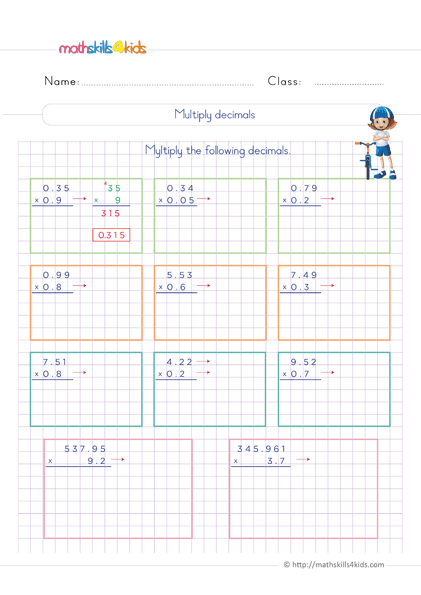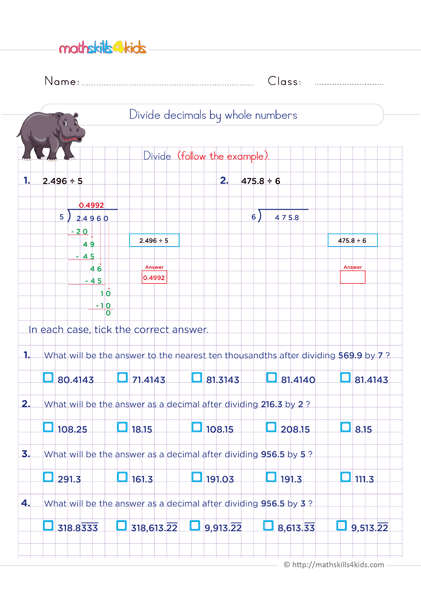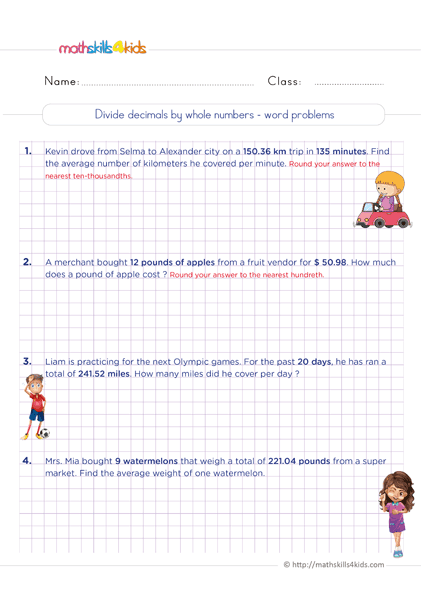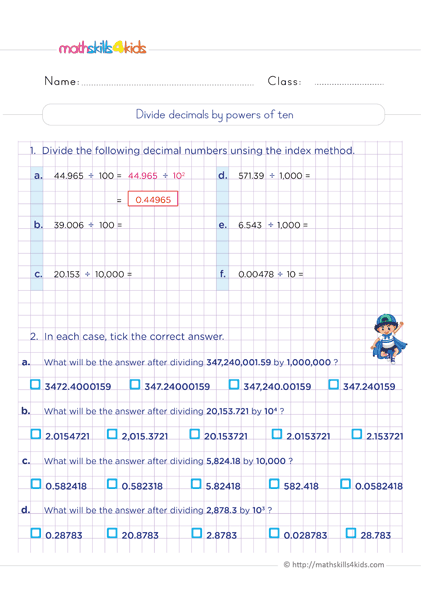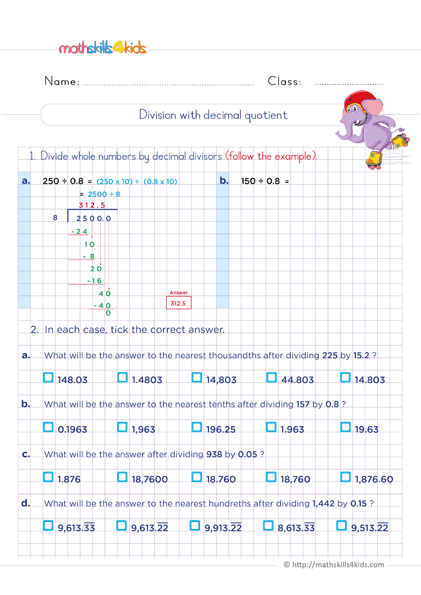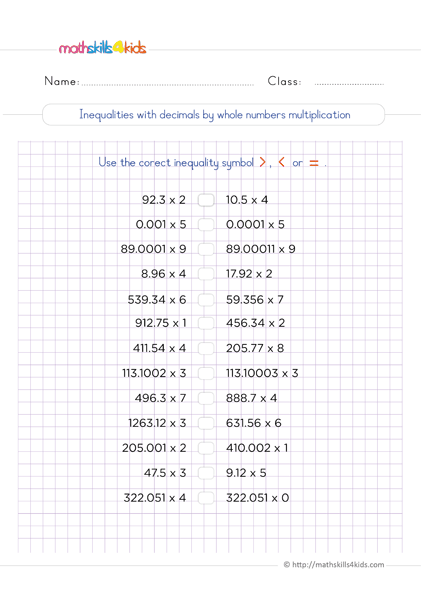6th Grade math: Multiplying and dividing decimals worksheets
Hello, and welcome to this enriching 6th Grade math article! As teachers and parents, we need to set 6th graders up for advanced math success with basic math concepts like decimals multiplication, and division. Today, we’re excited to share some fantastic multiplying and dividing decimals worksheets perfect for classroom and home use.
-
6th Grade Math Skills: Learn how to multiply and divide decimals with these fun and engaging worksheets
Are you ready to take your 6th-grade math skills to the next level? Look no further! With Mathskills4kids’ collection of fun and engaging worksheets, learning how to multiply and divide decimals will be a blast. These worksheets are designed to help 6th Grade students master the fundamentals of decimal operations and develop a deeper understanding of how decimals work in real-life situations.
From calculating the cost of groceries to solving measurement problems, these worksheets are designed to make learning math enjoyable and relevant. Each worksheet is carefully crafted to challenge your problem-solving abilities, providing step-by-step guidance and plenty of practice.
So, whether you're a student looking to sharpen your skills or a parent wanting to support your child's learning journey, these worksheets are the perfect tool to uplift 6th-grade math success.
-
BROWSE THE WEBSITE
-
DOWNLOAD FREE WORKSHEETS
-
-
GRADE 6 MATH TOPICS
- Whole numbers
- Multiplication
- Division
- Exponents and square roots
- Number theory
- Decimals
- Add & subtract decimals
- Multiply & divide decimals
- Fractions & mixed numbers
- Add & subtract fractions
- Multiply fractions
- Divide fractions
- Integers
- Operations with integers
- Mixed operations
- Rational numbers
- Problems solving
- Ratio & proportions
- Percentages
- Measuring units
- Money math
- Consumer math
- Telling time
- Coordinate graph
- Algebraic expressions
- One step equations
- Solve & graph inequalities
- Two-step equations
- 2D Geometry
- Symmetry & transformation
- 3D Shapes
- Geometry measurement
- Data and Graphs
- Statistics
- Probability
-
Buying is supporting us!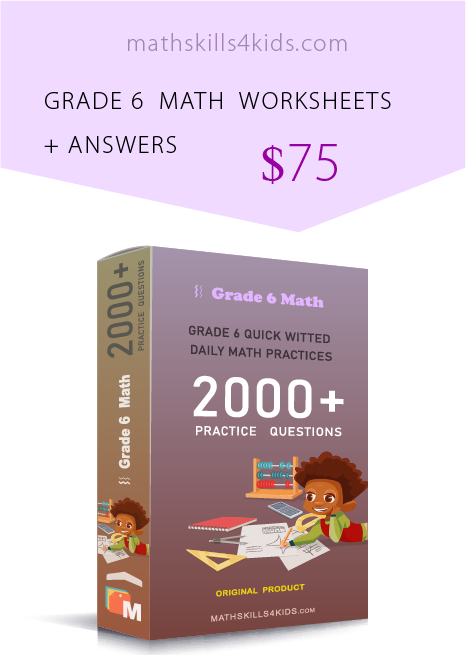
Buy Now...
-
-
Why are multiplying and dividing decimals important in 6th-grade math?
Hey! Do you know why multiplying and dividing decimals are important in 6th-grade math? Let’s find out together. But before then, let’s recall what decimals are.
Decimals are numbers with a decimal point, such as 0.5, 1.2, or 3.14. They represent fractions or parts of a whole, such as money, measurements, or percentages. Decimals are common in everyday life, so knowing how to work with them is essential.
Multiplying and dividing decimals are two of the most essential operations you'll need to perform with decimals. They allow you to calculate things like how much something costs, how much change you get, how long something takes, or how much of something you have. Multiplying and dividing decimals also help students prepare for more advanced math topics like ratios, proportions, algebra, and geometry.
-
Multiplying decimals: a step-by-step guide
To multiply decimals, we need to follow these steps:
- Ignore the decimal points and multiply the numbers as if they were whole numbers.
- Count the total number of digits after the decimal points in both numbers.
- Place the decimal point in the answer so that it has the same number of digits after it as the total we counted in Step 2.
For example, let's multiply 0.4 by 0.25:
- Ignore the decimal points and multiply 4 by 25. You get 100.
- Count the total number of digits after the decimal points in both numbers. There are two digits after the decimal point in 0.4 and two after the decimal point in 0.25. The total is four.
- Place the decimal point in the answer so that it has four digits after it. We get 0.0100, which can be simplified to 0.01.
-
Dividing decimals: a step-by-step guide
To divide decimals, we need to follow these steps:
- Move the decimal point in the divisor (the number you're dividing by) to the right until it becomes a whole number.
- Move the decimal point in the dividend (the number you're dividing) to the right by the same number of places as we moved it in the divisor.
- Divide the numbers as if they were whole numbers.
- Place the decimal point in the answer directly above where it is in the dividend.
For example, let's divide 0.75 by 0.25:
- Move the decimal point in the divisor (0.25) to the right two places until it becomes a whole number (25).
- Move the decimal point in the dividend (0.75) to the right two places too (75).
- Divide the numbers as if they were whole numbers (75 ÷ 25 = 3).
- Place the decimal point in the answer directly above where it is in the dividend (0.75). We get 0.03.
-
Fun and simple principles for multiplying and dividing decimals
Fun and simple principles for multiplying and dividing decimals are simply short techniques important to sharpen kid’s decimal multiplication and division calculating skills.
1. Multiplying decimals exercises with answers
Multiplying decimals exercises have modelled the simplest and shortest way to arrive at correct answers. The first thing usually is;
- Count and take note of the factors’ total number of decimal places (digits).
For example:
- Disregard the decimal points and multiply the factors as if they were whole numbers.

- Place your decimal point in your product, making sure that the number of decimal places in the product must equal the total number of decimal places in the factors.
Now, we can add our three (3) decimal places to the answer (315).
So we get 0.315
0.35 x 0.9 = 0.315
2. Dividing decimals exercises with answers
Dividing decimals has its own special and short calculating strategy different from multiplication. Here,
In the case where the divisor is a whole number, ( 6.496 ÷ 5 )
- Carry on a normal division process. Put the decimal point in the quotient location directly above its position in the dividend.
In the case the divisor is a decimal number ( 250 ÷ 0.8 ), we’ll; - First of all get rid of the decimal point from the divisor by multiplying it by10 or 100, depending on its number of decimal places, i.e. if the divisor has just one decimal place, we multiply by 10; two decimal places we multiply by 100, etc.
- Secondly, since we’ve multiplied the divisor, we’re obliged to multiply the dividend, so as to create an equilibrium. If we’d multiplied the divisor by either 10 or 100, we’ll also multiply the dividend by 10 or 100 respectively.
- When the products are gotten, we can now do our normal step by step division process.
- Note that, if your answer happens to be in a fraction form or has a remainder, place a decimal point and add a zero to the remainder, then continue dividing.
By so doing, your answer will be in a decimal and not in fraction form.
- Count and take note of the factors’ total number of decimal places (digits).
-
Review: How to multiply and divide decimals by powers of 10
A power of 10 is a number that has one or more zeros after a one, such as 10, 100, or 1000. Your 6th Grade students will find multiplying and dividing decimals by powers of 10 to be very easy if they remember this rule:
- To multiply a decimal by a power of 10, move the decimal point to the right by as many places as there are zeros in the power of 10.
- To divide a decimal by a power of 10, move the decimal point to the left by as many places as there are zeros in the power of 10.
For example;
- Let's multiply 0.03 by 100:
To multiply 0.03 by 100, we move the decimal point to the right by two places (because there are two zeros in 100). We’ll get 3.
- Let's divide 3 by 100:
To divide 3 by 100, we move the decimal point to the left by two places (because there are two zeros in 100). We’ll get 0.03.
-
Real-life applications of multiplying and dividing decimals
Multiplying and dividing decimals are not just abstract skills that you learn in math class. They are also useful for many real-life situations involving measurements, money, percentages, ratios, rates, etc. Here are some examples of real-life applications of multiplying and dividing decimals:
- If you want to buy a shirt that costs $12.99 and is on sale for 25% off, how much will you pay?
To find out, you multiply $12.99 by 0.25 (the decimal equivalent of 25%) to get the discount amount: $12.99 × 0.25 = $3.2475. Then subtract that amount from the original price to get the final price: $12.99 - $3.2475 = $9.7425.
- If you want to make a recipe that calls for 2 cups of flour and only have a measuring cup that holds half a cup, how many times do you have to fill it? To find out, you must divide 2 by 0.5 (the decimal equivalent of half) to get the number of times: 2 ÷ 0.5 = 4. You will fill the measuring cup four times to get 2 cups of flour.
- If you want to convert a temperature from Celsius to Fahrenheit, how do you do it? To find out, you have to use the formula F = C × 1.8 + 32, where F is the temperature in Fahrenheit and C is the temperature in Celsius. For example, if the temperature is 15°C, you have to multiply 15 by 1.8 and then add 32: F = 15 × 1.8 + 32 = 27 + 32 = 59°F.
- If you want to buy a shirt that costs $12.99 and is on sale for 25% off, how much will you pay?
Bonus: additional resources for practicing decimal skills
If you want to challenge your students with more practice on multiplying and dividing decimals, here are some web links with descriptions that you can check out:
- [mathsisfun.com] (https://www.mathsisfun.com/multiplying-decimals.html) (https://www.mathsisfun.com/dividing-decimals.html): This website has a variety of fun and interactive games that let 6th Graders practice adding, subtracting, multiplying, and dividing decimals. You can choose their difficulty level for them to play against the computer or a friend.
- [Khan Academy] (https://www.khanacademy.org/math/arithmetic/arith-decimals): This website has a comprehensive collection of videos and exercises that cover everything 6th graders need to know about decimals. They can learn at their own pace and track their progress with quizzes and badges.
- [Math-drills.com](https://www.math-drills.com/decimal.php): This website has hundreds of printable worksheets students can use to practice decimal skills. They can choose from different topics and difficulty levels and get instant feedback with answer keys.
-
Thank you for sharing the links of MathSkills4Kids.com with your loved ones. Your choice is greatly appreciated.
Conclusion
We hope you enjoyed this article and learned much about multiplying and dividing decimals. These skills are fundamental in 6th-grade math and beyond, as they help students solve real-world problems and understand fractions, percentages, ratios, etc.
Using our step-by-step guides, practice worksheets, and additional resources, your 6th Grade students can master decimal skills and ace their math tests.
Remember to download and print Mathskills4kids 6th Grade math Multiplying and dividing decimals worksheets and check out our bonus resources for more practice.
Have fun and happy learning!
